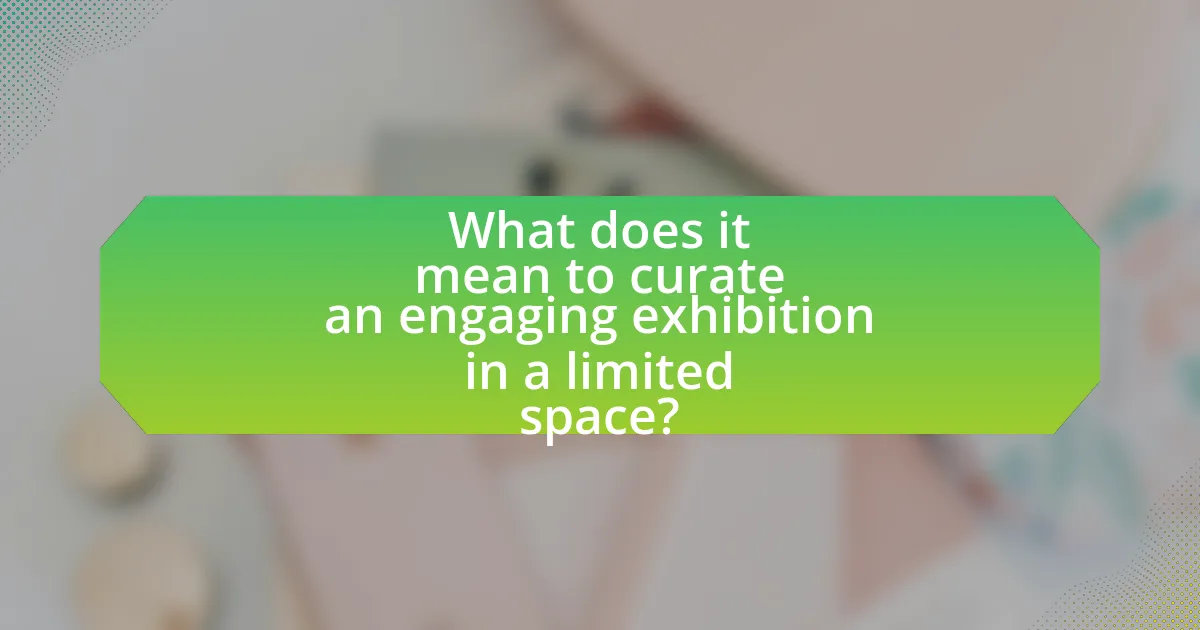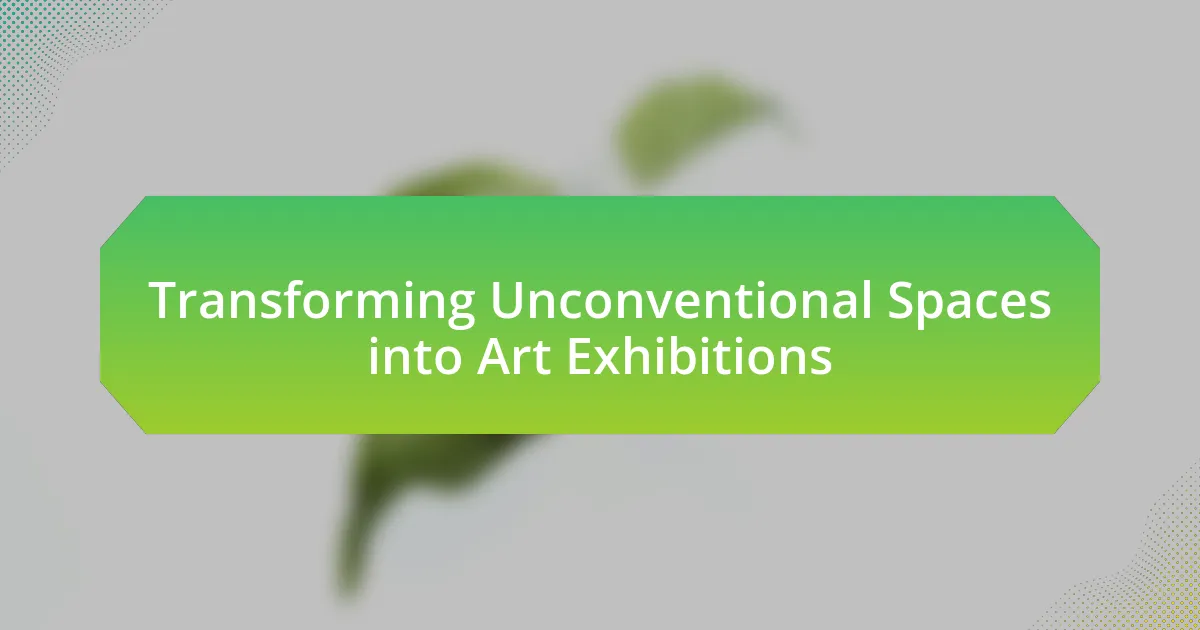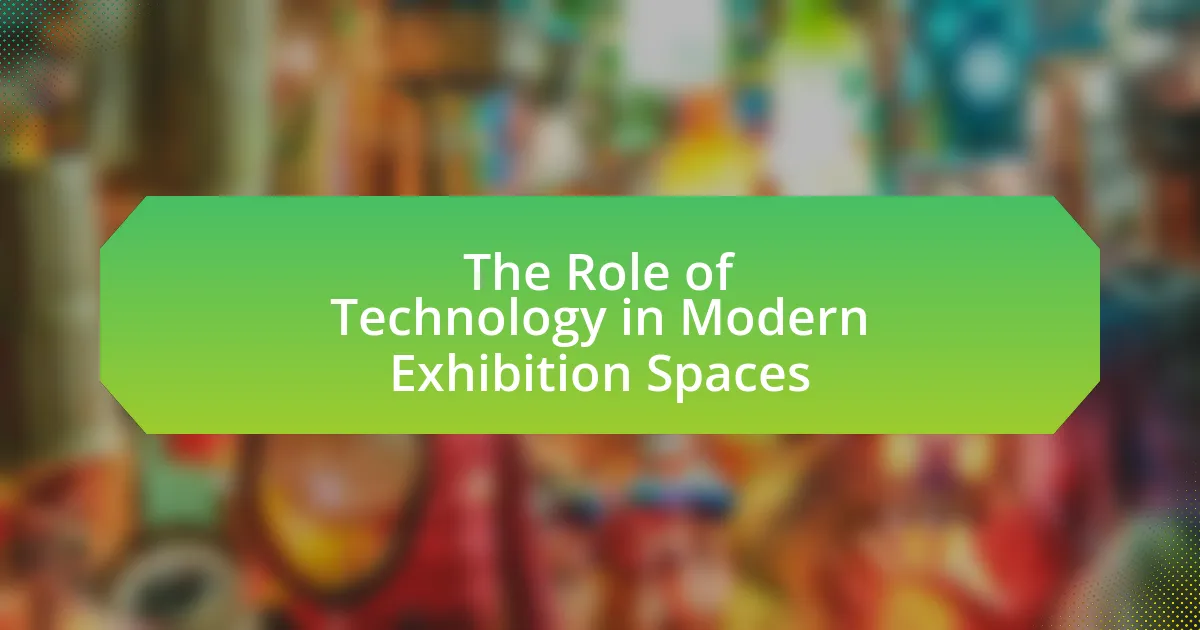Curating an engaging exhibition in a limited space involves the strategic selection and arrangement of artworks to create a cohesive experience for viewers. Key considerations include understanding spatial constraints, prioritizing thematic coherence, and utilizing innovative display techniques to enhance visitor interaction. Challenges such as restricted physical area and the need for effective layout design impact the selection of artworks and the overall visitor experience. Additionally, audience consideration, the integration of technology, and effective marketing strategies play crucial roles in maximizing engagement and ensuring the success of exhibitions in small venues. This article outlines best practices for curating exhibitions that captivate and educate audiences despite spatial limitations.

What does it mean to curate an engaging exhibition in a limited space?
Curating an engaging exhibition in a limited space means strategically selecting and arranging artworks or artifacts to create a cohesive and impactful experience for viewers. This involves understanding the spatial constraints and utilizing design principles such as balance, flow, and focal points to enhance the viewer’s interaction with the exhibition. For instance, the Museum of Modern Art in New York has successfully curated exhibitions in small galleries by focusing on thematic coherence and using innovative display techniques, demonstrating that thoughtful curation can maximize the impact of limited space.
How can space limitations impact exhibition curation?
Space limitations significantly impact exhibition curation by restricting the number of artworks and the layout design. Curators must prioritize which pieces to display, often leading to a more selective process that emphasizes quality over quantity. For instance, in a smaller gallery, curators may choose to focus on a thematic or narrative approach, allowing for deeper engagement with fewer works. Additionally, limited space can necessitate innovative display techniques, such as vertical installations or multi-functional furniture, to maximize the use of available area. This constraint can also influence visitor flow and interaction, as curators must design pathways that facilitate movement while ensuring that each piece is adequately highlighted.
What are the common challenges faced in limited exhibition spaces?
Common challenges faced in limited exhibition spaces include restricted physical area, which limits the number of exhibits that can be displayed, and the difficulty in creating an engaging flow for visitors. Limited space often necessitates careful selection and arrangement of artworks or artifacts, making it challenging to convey a cohesive narrative. Additionally, inadequate lighting and accessibility can hinder the overall visitor experience, as smaller spaces may not accommodate optimal viewing conditions or allow for easy navigation. These factors collectively impact the effectiveness of the exhibition in communicating its intended message and engaging the audience.
How does the size of the space influence the selection of artworks?
The size of the space significantly influences the selection of artworks by determining the scale, number, and arrangement of pieces that can be displayed. In smaller spaces, curators often prioritize artworks that are visually impactful yet compact, such as smaller paintings or sculptures, to avoid overwhelming the viewer. Conversely, larger spaces allow for the inclusion of larger installations or multiple pieces that can create a cohesive narrative or theme. For instance, a study by the Museum of Modern Art found that exhibitions in smaller galleries often feature fewer, more focused works to enhance viewer engagement, while larger galleries can accommodate diverse artworks that invite exploration. This relationship between space size and artwork selection is crucial for creating an effective and engaging exhibition.
What are the key elements of an engaging exhibition?
The key elements of an engaging exhibition include a clear theme, interactive displays, effective use of space, and audience involvement. A clear theme provides focus and context, guiding visitors through the exhibition’s narrative. Interactive displays encourage participation, making the experience memorable and immersive. Effective use of space ensures that the layout facilitates flow and accessibility, allowing visitors to engage with exhibits comfortably. Audience involvement, such as workshops or discussions, fosters a deeper connection and enhances the overall experience. These elements collectively contribute to an exhibition that captivates and educates its audience.
How do themes and narratives enhance visitor engagement?
Themes and narratives enhance visitor engagement by creating a cohesive and immersive experience that resonates emotionally with the audience. When exhibitions are organized around specific themes, they provide a framework that guides visitors through the content, making it easier to understand and relate to the material presented. For instance, a study by the American Alliance of Museums found that thematic exhibitions can increase visitor retention and satisfaction by up to 30%, as they help visitors connect personal stories with broader cultural contexts. This connection fosters deeper engagement, encouraging visitors to spend more time exploring and reflecting on the exhibition.
What role does layout play in creating an immersive experience?
Layout is crucial in creating an immersive experience as it dictates how visitors interact with the space and the exhibits. A well-designed layout guides the flow of movement, encourages exploration, and enhances engagement by strategically placing elements to draw attention and evoke emotions. For instance, studies show that open layouts can increase visitor dwell time by 30%, allowing for deeper interaction with the content. Additionally, the arrangement of exhibits can create thematic pathways that immerse visitors in a narrative, making the experience more cohesive and memorable.
Why is audience consideration crucial in exhibition curation?
Audience consideration is crucial in exhibition curation because it directly influences the effectiveness and engagement of the exhibition. Understanding the audience’s demographics, interests, and cultural backgrounds allows curators to tailor the content and presentation style, ensuring that the exhibition resonates with visitors. For instance, research by the American Alliance of Museums indicates that exhibitions designed with audience input lead to higher visitor satisfaction and increased attendance. By prioritizing audience needs, curators can create meaningful experiences that foster connection and enhance learning, ultimately making the exhibition more impactful.
How can understanding the target audience shape the exhibition’s design?
Understanding the target audience shapes the exhibition’s design by ensuring that the content, layout, and interactive elements resonate with the visitors’ interests and preferences. When designers analyze demographic data, such as age, cultural background, and educational level, they can tailor the exhibition to include relevant themes and accessible language, enhancing engagement. For instance, a study by the American Alliance of Museums found that exhibitions designed with audience input significantly increased visitor satisfaction and retention rates. This evidence underscores the importance of audience-centric design in creating meaningful and memorable experiences within limited exhibition spaces.
What methods can be used to gather audience feedback before the exhibition?
Surveys and questionnaires are effective methods to gather audience feedback before the exhibition. These tools can be distributed online or in-person to collect opinions on potential themes, content, and layout preferences. Research indicates that 70% of organizations that utilize surveys report improved audience engagement, as they allow for direct input from potential visitors, ensuring the exhibition aligns with their interests and expectations.
How can technology be utilized in a limited exhibition space?
Technology can be utilized in a limited exhibition space by incorporating digital displays, interactive kiosks, and augmented reality experiences. Digital displays allow for high-resolution images and videos to convey information without taking up physical space, while interactive kiosks engage visitors through touchscreens that provide additional content and context. Augmented reality can enhance the visitor experience by overlaying digital information onto physical exhibits, allowing for a more immersive interaction without requiring extra physical artifacts. These technological solutions not only maximize the use of limited space but also enhance visitor engagement and learning, as evidenced by studies showing that interactive and digital elements can increase visitor retention and satisfaction in exhibitions.
What types of digital tools can enhance visitor interaction?
Digital tools that can enhance visitor interaction include interactive kiosks, augmented reality applications, mobile apps, and social media platforms. Interactive kiosks provide engaging content and allow visitors to explore information at their own pace, while augmented reality applications can overlay digital information onto physical exhibits, creating immersive experiences. Mobile apps can facilitate guided tours and provide additional context, enhancing the overall visitor experience. Social media platforms enable real-time engagement and sharing, allowing visitors to connect and discuss their experiences. These tools have been shown to increase visitor engagement and satisfaction, as evidenced by studies indicating that interactive elements can boost visitor retention and learning outcomes in exhibitions.
How can virtual or augmented reality be integrated into the exhibition?
Virtual and augmented reality can be integrated into exhibitions by creating immersive experiences that allow visitors to interact with digital content related to the exhibition theme. For instance, augmented reality applications can overlay digital information onto physical exhibits, enhancing the storytelling aspect and providing additional context. Research shows that 70% of visitors find augmented reality experiences more engaging than traditional displays, as evidenced by a study conducted by the University of Maryland, which highlighted increased visitor retention and satisfaction when AR was utilized. Additionally, virtual reality can transport visitors to different environments or historical contexts, allowing them to experience the exhibition’s subject matter in a more profound way. This integration not only maximizes the use of limited space but also enriches the overall visitor experience.
What strategies can be employed to maximize limited space effectively?
To maximize limited space effectively in an exhibition, utilize vertical space, modular displays, and multi-functional furniture. Vertical space can be optimized by installing shelves or hanging artworks, allowing for more items to be displayed without occupying floor space. Modular displays enable flexibility in arrangement, accommodating various layouts and visitor flow. Multi-functional furniture, such as benches with storage, provides seating while also serving as display areas. Research indicates that effective use of vertical space can increase display capacity by up to 50%, enhancing visitor engagement and interaction.
How can modular displays optimize the use of space?
Modular displays optimize the use of space by allowing for flexible configurations that can adapt to various layouts and dimensions. This adaptability enables exhibitors to maximize their footprint, accommodating different exhibition sizes and shapes while ensuring that all elements are effectively showcased. For instance, modular systems can be reconfigured to fit into tight corners or to create open pathways, enhancing visitor flow and engagement. Additionally, the use of lightweight materials in modular displays reduces the overall weight and bulk, making it easier to transport and set up in diverse environments, further contributing to efficient space utilization.
What are the benefits of using multi-functional furniture in exhibitions?
Using multi-functional furniture in exhibitions maximizes space efficiency and enhances visitor engagement. This type of furniture serves multiple purposes, such as seating, display, and storage, allowing for a more versatile layout that can adapt to various needs. For instance, a bench that doubles as a display unit not only saves space but also encourages interaction by inviting visitors to sit and engage with the displayed content. Additionally, studies show that well-designed multi-functional spaces can improve visitor flow and satisfaction, as they create a more dynamic and inviting atmosphere.
How can effective marketing enhance the success of a limited space exhibition?
Effective marketing enhances the success of a limited space exhibition by increasing visibility and attracting a targeted audience. By utilizing strategies such as social media promotion, email campaigns, and partnerships with local influencers, organizers can create buzz and drive attendance. For instance, a study by the Event Marketing Institute found that 84% of attendees are influenced by social media when deciding to attend an event. This demonstrates that effective marketing not only raises awareness but also engages potential visitors, ultimately leading to higher foot traffic and greater overall success for the exhibition.
What channels are most effective for promoting exhibitions in small venues?
Social media platforms, particularly Instagram and Facebook, are the most effective channels for promoting exhibitions in small venues. These platforms allow for targeted advertising and organic reach, enabling venues to engage with local audiences and art enthusiasts. According to a study by the Pew Research Center, 69% of adults in the U.S. use Facebook, making it a prime channel for event promotion. Additionally, Instagram’s visual nature is particularly suited for showcasing artwork, with 67% of users stating they discover new products and services through the platform. Utilizing these channels can significantly enhance visibility and attendance for exhibitions in limited spaces.
How can social media campaigns drive attendance to the exhibition?
Social media campaigns can drive attendance to the exhibition by effectively targeting and engaging potential visitors through tailored content and strategic advertising. By utilizing platforms like Facebook, Instagram, and Twitter, organizers can create visually appealing posts, event pages, and targeted ads that highlight key attractions of the exhibition, such as featured artists or unique installations. Research shows that 54% of social media users use these platforms to discover events, indicating that a strong online presence can significantly increase visibility. Additionally, leveraging user-generated content and encouraging attendees to share their experiences can create a sense of community and anticipation, further boosting attendance.
What are some best practices for curating an engaging exhibition in a limited space?
To curate an engaging exhibition in a limited space, prioritize a clear theme that resonates with the audience. This focused approach allows for a cohesive narrative, making it easier for visitors to connect with the displayed works. Utilize vertical space effectively by hanging artworks and incorporating shelving to maximize visibility without overcrowding. Additionally, consider the flow of the exhibition; create a logical path that guides visitors through the space, enhancing their experience. Incorporating interactive elements can also engage visitors more deeply, as studies show that participatory experiences increase retention and enjoyment. Finally, limit the number of pieces displayed to avoid overwhelming the audience; research indicates that fewer, well-chosen works can lead to a more impactful experience.
How can collaboration with artists enhance the exhibition experience?
Collaboration with artists enhances the exhibition experience by integrating unique perspectives and creative expressions that engage audiences more deeply. When artists contribute their vision, they can transform traditional exhibition formats into immersive environments, fostering emotional connections and stimulating dialogue among visitors. For instance, interactive installations or live performances can create dynamic experiences that encourage participation, making the exhibition memorable. Research indicates that exhibitions featuring artist collaborations often see increased visitor engagement and satisfaction, as evidenced by a study from the National Endowment for the Arts, which found that participatory art experiences significantly boost audience involvement and retention.
What tips can ensure a cohesive and engaging visitor journey?
To ensure a cohesive and engaging visitor journey, curators should create a clear narrative that guides visitors through the exhibition. This can be achieved by strategically organizing exhibits in a logical sequence, using thematic groupings that resonate with the overall message. Research indicates that well-structured narratives enhance visitor retention and satisfaction, as evidenced by a study published in the Journal of Museum Education, which found that 75% of visitors preferred exhibitions with a defined storyline. Additionally, incorporating interactive elements and multimedia can further engage visitors, making the experience more immersive and memorable.






